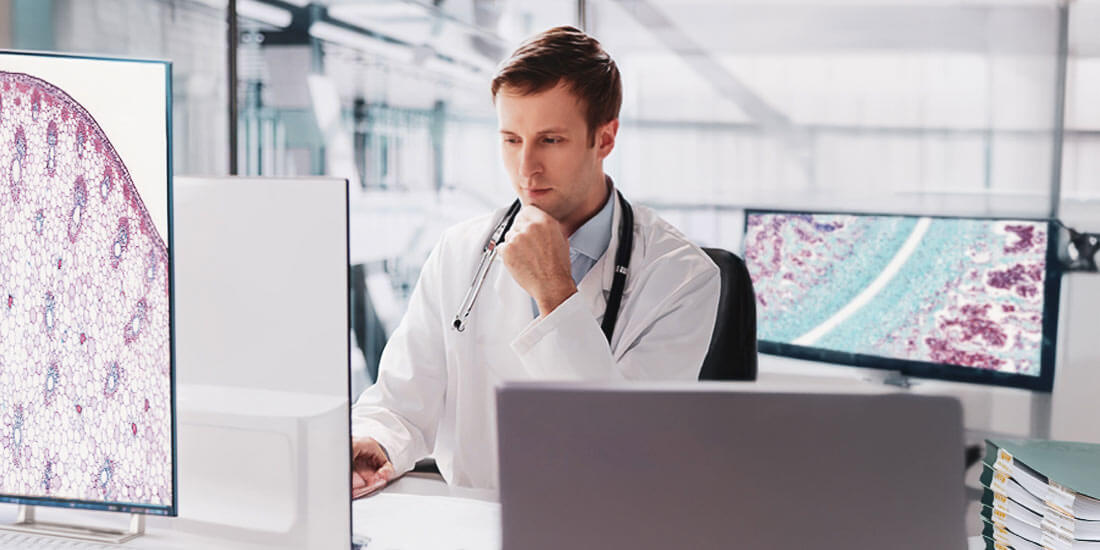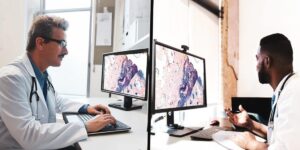Synopsis
The transition to virtual microscopy has been a key shift in the rapidly evolving field of pathology in recent years. While this shift has brought a plethora of benefits to the laboratory, it has also presented many challenges. Pathologists embarking on the path to virtual microscopy should not view these challenges as overwhelming, but rather as obstacles that can be overcome through strategic planning. A key advantage in this transition process is benefiting from the evolving technology landscape and getting help from support services. These resources play a key role in addressing concerns related to digital efficiency, and other potential obstacles. By carefully organizing and developing a transition strategy, pathologists can adopt virtual microscopy with confidence, ensuring a smooth and seamless transition that minimizes disruption while maximizing efficiency.
Navigating the Transition Through Virtual Microscopy
Significant technological advancements in modern pathology have contributed to the adoption of virtual microscopy. Features such as better image quality, slide navigation, higher display speed, depth of focus, storage cost, and scanning time make shifting to virtual microscopy worth its value. However, to reap the full benefit, you need to have answers to questions about image quality and accuracy, data security and privacy, communication and technology, ergonomics and workflow efficiencies, legal issues, cost, and resistance to change.
Digital Competency
A significant barrier to the transition to virtual microscopy lies around digital competence. Previous generations of pathologists have significant gaps in their familiarity with digital tools and technologies. Acquiring the skills to efficiently navigate digital platforms, effectively use customized software to scan slides, and efficiently manage digital archives can be a daunting learning process for many in this field.
Solution: Comprehensive training programs and workshops can help you master the digital skills you need. Organizations should invest in ongoing education and support to ease the transition.
Image Quality and Resolution
You always rely on high-resolution images to make an accurate diagnosis. During the transition, there are often concerns about whether the clarity and detail of digital images will be the same as digital microscope slides.
Solution: It’s important to make sure you’re using high-quality scanning equipment and software. You should also be familiar with image enhancement techniques to maximize the quality of the digital images.
Data Security and Privacy
One of the biggest concerns in healthcare is data security. When using virtual microscopes, there is a need to ensure that patient information is secure and complies with all legal requirements. Unauthorized access, data leakage, or poor management of digital files can pose a significant risk.
Solution: Strong security protocols, encryption procedures, and access controls must be in place to protect patient data. Compliance with relevant regulations is critical.
Communication and Technical Issues
In virtual microscopy, the cornerstones of smooth operation are a reliable Internet connection and a well-maintained technical infrastructure. These elements are crucial as they facilitate uninterrupted viewing and sharing of digital slides. Any technical glitch, whether it’s a slow upload time or a system crash, can seriously disrupt the diagnostic workflow, so a strong technical foundation is essential.
Solution: A key component of a successful virtual microscope installation is ongoing IT support. Labs and institutions should invest in high-speed Internet connections and remove redundant systems from the network to minimize downtime.
Ergonomics and Workflow Efficiency
Traditional microscopes allow you to physically handle the objective and adjust focus and illumination as needed. In a virtual environment, it is difficult to achieve the same level of control. Navigating through slides and managing multiple cases at once can be less intuitive, which impacts workflow efficiency.
Solution: Provide ergonomic workstations and hardware designed specifically for virtual microscopy. Customizable software settings and user-friendly interfaces help you adapt to digital workflows more smoothly.
Collaboration and Communication
Pathology often requires collaboration and communication between specialists. While traditional microscopy requires face-to-face interaction, virtual microscopy can be a key to communication.
Solution: You need to implement technology solutions that incorporate real-time communication. Videoconferencing and secure communication platforms can bridge this gap and enable remote consultations.
Legal Challenges
Complying with legal requirements in the digital space can be complicated. Different regions have different regulations regarding the handling of digital pathology data. It is important to keep in mind the compliance requirements of the respective place of work.
Solution: At the beginning, you need to work closely with legal experts and regulators to establish clear guidelines for digital pathology practices. You need to develop robust documentation and record retention protocols to meet legal requirements.
Costs and Budget Challenges
While the long-term benefits of virtual microscopy are indisputable, it is important to recognize that the initial investment in digital infrastructure can be high. Smaller healthcare organizations, in particular, may face significant challenges in ensuring a smooth transition due to financial factors.
Solution: From the outset, it is important to prioritize exploring cost-effective solutions and consider a phased approach to implementation. Additionally, exploring grant or funding opportunities can help facilitate a smooth transition. Conducting a comprehensive cost-benefit analysis is another valuable step, as it demonstrates the actual value that virtual microscopy brings to a healthcare organization.
Resistance to Change
Resistance to change is a common challenge across industries. This sentiment often stems from concerns about disrupting established practices and increasing complexity.
Solution: Labs can counter resistance with effective change management strategies. These strategies may include communicating the benefits of virtual microscopy, involving pathologists in the decision-making process, and providing support and training to ease the transition.
Conclusion
The shift to virtual microscopy results in high-quality outcomes. It is an important step forward in pathology, offering remote access, enhanced collaboration, and improved record-keeping. Along with the advantages, some specific challenges have emerged. However, advances in technology and rapid access to a variety of services have made it easier to overcome these challenges. Whether it’s digitization capabilities, image quality, data security, technology infrastructure, or workflow efficiency, a well-developed strategy can overcome each of these challenges. This strategic approach gives pathology laboratories the ability to intelligently transition to virtual microscopy to provide more efficient and accurate diagnostic services.











